Mugen Motorsports
Mugen Motorsports (M-TEC Co., Ltd) (無限) is a Japanese company formed in 1973 by Hirotoshi Honda, the son of Honda Motor Company founder Soichiro Honda, and Masao Kimura.[1] Mugen, meaning "Without Limit", "Unlimited" or "Vast",[2] (hence the commonly placed word "Power" after, denoting "Unlimited Power") is an engine tuner and parts manufacturer that manufactures OEM parts such as body kits and sports exhausts for Honda Motor Company. Despite the family connections, however, Mugen is not, and has never been, owned by Honda Motor Company; Mugen owner Hirotoshi Honda has been the biggest shareholder in Honda since his father's death in 1991.[3]
Mugen Power | |
| Industry | Automotive industry |
|---|---|
| Founded | 1973 (2003 M-TEC) |
| Founder | Hirotoshi Honda |
| Headquarters | 2-15-1 Hizaori, , |
| Website | www |
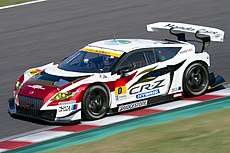
The company tunes and races Honda vehicles in the Super GT championship, and, additionally, sells aftermarket parts to amateur enthusiasts. It was part of partnerships that won the Formula 3000 championship in 1990 and 1991, and that eventually led to Mugen's involvement in Formula One, from 1992 to 2000, and up to 2005 was the exclusive supplier of Formula Nippon engines.
Corporate history
The company has a strong racing heritage, as Hirotoshi Honda began building his own racing car in a workshop at his father's house, shortly before he graduated from Nihon University in 1965. Masao Kimura is a veteran racer with more than 50 victories in Honda sports cars and single-seaters and worked for Honda R&D and then Honda Racing Service before helping Hirotoshi Honda establish Mugen.
In 1973, Mugen started its operations and initially offered special parts of motocross bikes.[3] As Honda expanded its vehicle lineup, Mugen's product range also expanded. The company started specializing in tuning Honda engines. Beginning with the 1200 cc Honda Civic engine, it went on to develop, and now designs and builds, both two-stroke and four-stroke engines, manufacturing many of the major components itself.
Mugen ultimately intends to build its own road cars and the first step towards this was the creation of bodykits for the Honda Ballade CR-X in 1984. Since then, the company has produced a number of body kits for Honda machinery, culminating with the Mugen NSX prototype in 1992.[4]
Following Hirotoshi Honda's tax evasion allegation in late 2003, Mugen was restructured in early 2004 with the establishment of M-TEC. The new company retained the right to use the Mugen trademark and its headquarters in Asaka, Saitama, in the northern suburbs of Tokyo close to the Honda R&D facility at Wako. Although it is a legally separate entity, M-TEC kept Mugen's existing staff and is headed by former Mugen board member Shin Nagaosa, who was the engineering division manager at Mugen and been involved with running Mugen's NSX racing program.
Mugen Racing
Single-seaters
Working with Honda, Mugen has gradually expanded its sporting involvement to all levels of the sport. In 1986, Formula 3000 was introduced into Japan and Mugen joined forces with Honda to build an F3000 engine. It was introduced in the 1987 season and leased to 14 teams. The following year, Mugen won four of the top five places in the Japanese F3000 championship. In 1989, Mugen entered European F3000 with the MF308 engine and won the championship with Jean Alesi, driving an Eddie Jordan Racing Reynard. The same year the company produced its own prototype 3.5L V8 Formula One engine, codenamed MF350.
In 1988, Mugen started tuning Honda engines for use in Formula Three, winning the Japanese series with Akihiko Nakaya, and in 1990 expanded their business to Europe. The same year, Mugen won its first Formula Three championships in Europe, taking the French title with Éric Hélary, and the British crown with Mika Häkkinen at the wheel of a West Surrey Racing Ralt, which repeated the title in 1991 with Rubens Barrichello.
As F3000 became a spec-series in Europe starting in 1996 with the Lola-Judd combo, the Japanese series responded by making Mugen the sole supplier to the Japanese championship, now redubbed Formula Nippon. M-TEC lost the supply contract for the 2006 season, with the rules changing to allow Toyota associate TOM'S to join Mugen as engine supplier.
Mugen continues to enjoy success in the Formula Three circuit with its tuned 2.0 L Honda engines, having won 9 titles in Asia (8 of which in Japan) since 1988, as well as 19 titles in Europe (15 of them in Britain), and 13 in Latin America.
As of 2017, Mugen Formula engines still enjoy use and success across the various European hillclimb championships, employed in former Formula chassis and dedicated hillclimb prototypes.
Formula One
| Formula One World Championship career | |
|---|---|
| First entry | 1992 South African Grand Prix |
| Last entry | 2000 Malaysian Grand Prix |
| Races entered | 147 |
| Chassis | Footwork, Lotus, Ligier, Prost, Jordan |
| Constructors' Championships | 0 |
| Drivers' Championships | 0 |
| Race victories | 4 |
| Podiums | 16 |
| Points | 182 |
| Pole positions | 1 |
| Fastest laps | 0 |
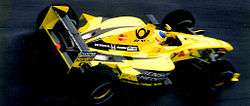
In 1991 Mugen prepared Honda V10 engines for Tyrrell (based on engines used by McLaren in 1989 and 1990), but the following year these engines were renamed Mugen MF351H and were transferred to the Footwork team, with drivers Aguri Suzuki and Michele Alboreto. Although Honda withdrew from the sport at the end of 1992 season, Mugen remained affiliated with Footwork in 1993 and created a B version of the MF351H, used by Aguri Suzuki and Derek Warwick.
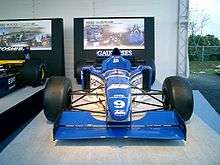
At the end of the year, Mugen switched to Team Lotus with plans for a new Lotus 109. The team - with drivers Johnny Herbert and Pedro Lamy (later replaced by Alessandro Zanardi) - was underfunded and the 109 chassis was late arriving. The Mugen engine, codenamed MF351HC, was not able to show its full potential, the team consequently failed to score a single World Championship point during 1994 despite coming close on 3 occasions, this was the only season in which Mugen engines did not score a World Championship point during their time in Formula One.
After Lotus closed at the end of the year, Mugen switched to the Ligier team, which was then being run for Flavio Briatore by Tom Walkinshaw, with drivers Olivier Panis, Martin Brundle and Aguri Suzuki, although it was initially planned for the Minardi team. The 3.0 L engine, conforming to the new regulations, was codenamed MF301H. The 1995 season was promising with points being scored at 9 races and the team securing 2 podiums, one courtesy of Martin Brundle finishing 3rd at the Belgian Grand Prix and the other by Olivier Panis finishing 2nd at the Australian Grand Prix, the team secured 24 points and finished a respectable 5th in the Constructors Championship. The following season with Ligier resulted in Mugen's first Formula One victory as well as Ligier's last ever Formula One victory at the 1996 Monaco Grand Prix with Panis at the wheel. Despite this unexpected success, the Mugen powered Ligier car was only able to score 3 more points finishes during the rest of the season two 6th-place finishes from Pedro Diniz and one 5th-place finish from Panis; the team suffered 17 retirements during 1996.
Ligier was taken over by Alain Prost in 1997, and the newly named Prost Grand Prix ran MF301H-B engines with Jarno Trulli leading the Austrian Grand Prix before suffering an engine failure. the Prost team managed two podium finishes during the 1997 season at Brazil and Spain, they scored points in 8 races over the season securing a final total of 21 points and a 6th-place finish in the Constructors Championship
With Prost establishing a relationship with Peugeot and switching to them from 1998 onwards, Mugen looked for a new partner and reached a two-year agreement with Jordan Grand Prix for which Mugen produced the MF301H-C engine. The first half of the 1998 season was an absolute disaster; it was so bad that at one point Mugen officials met with Eddie Jordan and his team during the 1998 Monaco Grand Prix to find out why up until then the team had failed to score a single World Championship point. The relationship continued at Silverstone where the team scored their first World Championship point of the season courtesy of a 6th-place finish from Ralf Schumacher, followed by points finishes at the next 3 races. It was not until Spa-Francorchamps, when Jordan's fortunes changed for the better with drivers Damon Hill and Ralf Schumacher scored a 1-2 finish securing Jordan's first ever Formula One victory and their only 1-2 finish during their existence after a crash-marred start. The team would score points on two further occasions with Ralf achieving a 3rd-place finish at the Italian Grand Prix.
The 1999 season resulted in further success with Heinz-Harald Frentzen winning twice in France and Italy and even challenging for the title, although he failed in doing so due to better performance from McLaren and Ferrari. After Honda returned to the sport from 2000 with British American Racing, Mugen left Formula One after another year of having both Honda and Mugen engines racing together, leaving Honda to supply the engines to Jordan as well in 2001 and 2002. The 1999-specification engines were also used for the Honda RA099, a test car to prepare for Honda's factory engine supply operation, while 1995 engines were used for the RC101B/RC-F1 2.0X, a car built by the Honda R&D Center without direct support from Honda headquarters; previous cars built by the R&D Center used older Honda engines when they supplied engines for McLaren.
Sportscar racing
In 1998, Mugen built four NSX models, two for the Mugen/Dome partnership, one for Team Kunimitsu and one for Nakajima Racing. The cars were fast but unreliable at first, until the Nakajima NSX scored the car's first win at the fourth round in Fuji. This was followed by three more wins (one of them by the Mugen/Dome team), which led to a second place championship finish for Tom Coronel and Kouji Yamanishi. In 1999, the Honda took three more wins, one of those with the Mugen/Dome team of Juichi Wakisaka and Katsutomo Kaneishi scoring a victory at the opening round in Suzuka and finishing the third best team in the championship. In 2000, the Mugen/Dome team was champion with Ryo Michigami, but the car's performance was limited by regulation changes and Michigami reached the title without a single win. Still, Honda won four races, one of them by the second Mugen/Dome car.
In 2001, Mugen concentrated once more in the JGTC, the NSX winning two races, and finishing second (Mugen/Dome) and third (ARTA) in the series. More importantly, in June, the company announced development of a new 4.0 L V8, dubbed MF408S, for the main prototype class in the 24 Hours of Le Mans and American Le Mans Series. At the time, Mugen acknowledged that international sportscar racing was a new category for them. The concept of the MF408S was high power, compact size, durability and reliability. Mugen chose a 4.0 L (N/A) Naturally aspirated engine because they felt through their experience in Formula Three that restrictor size was key to performance. The idea was to save fuel with a smaller displacement engine, since, theoretically, restrictor size will bring power in any engine to a similar level. The main engines in use at the time were producing around 600 hp, including the turbocharged Audi and Cadillac, as well as the larger displacement BMW and the Roush-prepared Ford. Mugen excluded a turbo as this necessitated use of intercoolers to extract maximum performance, which added to the weight and reduced performance.
2002 was a good year for Mugen at the track. The Mugen-prepared NSXs won five rounds, with the Mugen/Dome team winning two races outright, which gave them the Team's championship title. The debut of the MF408S was in a Panoz chassis in the 2002 Sebring 12 Hours, first round of ALMS.
In 2004, M-TEC decided to drop down to GT300 and help train Japanese drivers for GT500 speeds. By grabbing promising drivers early in their careers, M-TEC would then be able to mold them and have definite access to future champions. M-TEC driver, Hiroyuki Yagi, was sourced from the Integra Series. Giving the drivers experience was more important than developing the car to take the championship. To this end, M-TEC simply detuned the car for the GT300 class without optimizing it for the new power level. Winning the GT300 series by one point over the ARTA Garaiya was simply an unintended bonus for a dedicated, championship-level team.
Breaking into the United States is another goal for the M-TEC team and the Mugen name. Currently, the authorized dealer of Mugen parts in the US is King Motorsports. Team director Junichi Kumakura thought racing the NSX in the United States was a great way to promote the company in a previously unvisited environment. When asked what else M-TEC would like to accomplish in America with the golden NSX, competing at Sebring and Daytona were marked as attractive goals.
MF408S Engine Technical Specifications
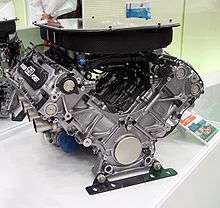
- Engine Name: MF408S
- Engine: 90° V8, naturally aspirated
- Displacement: 4,000 cm³
- Bore x Stroke: 97 mm x 67 mm
- Max Power: Over 456 kW (612 hp; 620 PS) @ 9,500 rpm[5]
- Max Torque: Over 520 N⋅m (380 lb⋅ft) @ 7,500 rpm[5]
- Restrictor Size: 33.4 mm x2 or 46.8 mm x1
- Ignition Type: Direct Injection
- ECU System: EFI Technology Inc
- CDI System: EFI Technology Inc
- Clutch Type/Size Carbon / 5.5 inch 4-plate
- Maintenance Interval: >3,000 km (>5,000 km at Le Mans 24h)
- Length: 559 mm (not including flywheel)
- Height: 577 mm (not including flywheel)
- Width: 720 mm
- Weight: 131 kg
- Crank Height: 92 mm
MF 458S Engine Technical Specifications
Engine Name: MF458S
- Engine: 90° V8, naturally aspirated
- Displacement: 4,500 cm³
- Bore x Stroke: 100 mm x 71.6 mm
- Max Power: 600+ hp (460 kW) @ 8,250 rpm
- Max Torque: 398 lbf·ft (587 N·m) @ 7,000 rpm
- Restrictor Size: 33.1 mm x2 or 46.6 mm x1
- Ignition Type: Direct Injection
- ECU System: EFI Technology Inc
- CDI System: EFI Technology Inc
- Clutch Type/Size Carbon / 5.5 inch 4-plate
- Maintenance Interval: >3,000 km (>5,000 km at Le Mans 24h)
- Length: 559 mm (not including flywheel)
- Height: 577 mm (not including flywheel)
- Width: 720 mm
- Weight: 131 kg
- Crank Height: 92 mm
Motorcycle Racing
Isle of Man TT Races
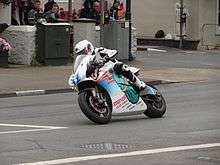
Mugen have become the dominant force in electrically powered motorcycles competing at the Isle of Man TT Races. In the eight years since their introduction into the TT Zero, the average speed of the Mugen Shinden around the Snaefell Mountain Course has increased from 102.215 mph (164.499 km/h) in 2012 to 121.91 mph (196.20 km/h) in 2019.[6] By 2019, Mugen has won five TT Zero races using its Shinden bikes.[7]
- 2012
Making their competitive debut at the 2012 Isle of Man TT, John McGuinness took the Mugen Shinden Ni to second place behind the MotoCzysz of Michael Rutter at an average speed of 109.527 mph.[6]
- 2013
At the 2013 TT Mugen again finished runners up to MotoCzysz, with Rutter and McGuinness repeating the previous year's result.[6]
- 2014
Mugen's development has continued at subsequent races in the TT Zero Category. Fielding two machines at the 2014 Isle of Man TT, John McGuinness secured their maiden victory ahead of teammate Bruce Anstey who took second place on the other Shinden San.[6]
- 2015
At the 2015 TT McGuinness and Anstey again took the first two spots on the rostrum.[6]
- 2016
Mugen continued their dominance in the TT Zero class at the Isle of Man TT Races in 2016, when Bruce Anstey took the honours, although their other machine, ridden by John McGuinness, retired during the one lap event.
- 2017
Anstey and Guy Martin came first and second respectively, both riding Mugen machines.
- 2018
The Mugen motorcycles achieved first and third place with Michael Rutter and Lee Johnston respectively, split by Daley Mathison riding for the University of Nottingham. Rutter broke the 120 mph barrier to set a new lap record of 121.824 mph (196.057 km/h).
2019
With Shinden Hachi, Mugen achieved their sixth consecutive victory with Michael Rutter again increasing the lap record average speed to 121.91 mph. John McGuinness followed his team-mate home to complete a 1-2 finish for the team.
Vehicles
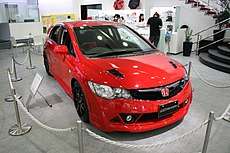
M-Tec has also built concept Honda vehicles, using the company's own performance parts. Some models (e.g.: Mugen Civic RR) are also sold in Japanese domestic market.
List of Mugen vehicles
- Honda City Turbo I and II
- 1984 Mugen Honda CR-X
- 1992-1995 Honda Civic SiR I and II Mugen (hatchback model and sedan model)
- 1996-2001 Honda Integra Type-R Mugen
- 1994-1997 Acura/Honda Integra Mugen (bugeye version)
- 1997 Mugen CRX Del Sol
- 1996-2000 Honda Civic SiR Mugen hatchback coupe and sedan model
- 2004 Honda Fit Dynamite
- 2005 Honda Legend Max
- 2006 Honda Fit Spec.D
- 2006 Honda Civic Dominator
- the Road to Racing Concept (Honda Civic-based) (2007)
- Open-Top Pure Sports Concept (Honda S2000-based) (2007)
- Mugen Courage LC70 (Japan Le Mans Challenge LMP-1) (2007)
- Mugen S2000 (2008)
- Honda Fit F154SC (2008)[8]
- Mugen RR Experimental Spec. (Honda Civic Type R-based) (2008)
- Honda Civic 5D MUGEN[9][10] (2008)
- Honda NSX Mugen RR (2009)
- Honda Civic Mugen RR Advanced Concept (2009)
- Honda Accord Mugen 24sc (2009)
- Honda Odyssey Mugen (2009)
- Honda Insight ZE2 (Mugen Zero-Lift) (2010)
- Honda CR-Z: RR Concept (2012)
- Honda CBR1000RR
- Honda City ZX 2009
Production vehicles
- 2008 Civic Mugen Si marketed in North America
- 2007 Civic Mugen RR marketed in Japan
- CR-Z Mugen
- Prelude Mugen
- Accord Mugen
Formula One statistics
| Year | Team | GPs | Wins | Pole Position | Podiums | Fastest laps | Points |
|---|---|---|---|---|---|---|---|
| 1992 | Footwork-Mugen Honda | 16 | 0 | 0 | 0 | 0 | 6 |
| 1993 | Footwork-Mugen Honda | 16 | 0 | 0 | 0 | 0 | 4 |
| 1994 | Lotus-Mugen Honda | 16 | 0 | 0 | 0 | 0 | 0 |
| 1995 | Ligier-Mugen Honda | 17 | 0 | 0 | 2 | 0 | 24 |
| 1996 | Ligier-Mugen Honda | 16 | 1 | 0 | 1 | 0 | 15 |
| 1997 | Prost-Mugen Honda | 17 | 0 | 0 | 2 | 0 | 21 |
| 1998 | Jordan-Mugen Honda | 16 | 1 | 0 | 3 | 0 | 34 |
| 1999 | Jordan-Mugen Honda | 16 | 2 | 1 | 6 | 0 | 61 |
| 2000 | Jordan-Mugen Honda | 17 | 0 | 0 | 2 | 0 | 17 |
Complete Formula One results
(key) (results in bold indicate pole position)
| Year | Entrant | Chassis | Engine(s) | Drivers | 1 | 2 | 3 | 4 | 5 | 6 | 7 | 8 | 9 | 10 | 11 | 12 | 13 | 14 | 15 | 16 | 17 | Points | WCC |
|---|---|---|---|---|---|---|---|---|---|---|---|---|---|---|---|---|---|---|---|---|---|---|---|
| 1992 | Footwork Mugen Honda | Footwork FA13 | MF-351H 3.5 V10 | RSA | MEX | BRA | ESP | SMR | MON | CAN | FRA | GBR | GER | HUN | BEL | ITA | POR | JPN | AUS | 6 | 7th | ||
| 10 | 13 | 6 | 5 | 5 | 7 | 7 | 7 | 7 | 9 | 7 | Ret | 7 | 6 | 15 | Ret | ||||||||
| 8 | DNQ | Ret | 7 | 10 | 11 | DNQ | Ret | 12 | Ret | Ret | 9 | Ret | 10 | 8 | 8 | ||||||||
| 1993 | Footwork Mugen Honda | Footwork FA13B Footwork FA14 |
MF-351 HB 3.5 V10 | RSA | BRA | EUR | SMR | ESP | MON | CAN | FRA | GBR | GER | HUN | BEL | ITA | POR | JPN | AUS | 4 | 9th | ||
| 7 | 9 | Ret | Ret | 13 | Ret | 16 | 13 | 6 | 17 | 4 | Ret | Ret | 15 | 14 | 10 | ||||||||
| Ret | Ret | Ret | 9 | 10 | Ret | 13 | 12 | Ret | Ret | Ret | Ret | Ret | Ret | Ret | 7 | ||||||||
| 1994 | Team Lotus | Lotus 107C | MF-351 HC 3.5 V10 MF-351 HD 3.5 V10 |
BRA | PAC | SMR | MON | ESP | CAN | FRA | GBR | GER | HUN | BEL | ITA | POR | EUR | JPN | AUS | 0 | NC | ||
| 10 | 8 | Ret | 11 | ||||||||||||||||||||
| 9 | 15 | ||||||||||||||||||||||
| 7 | 7 | 10 | Ret | ||||||||||||||||||||
| Lotus 109 | Ret | 8 | 7 | 11 | Ret | Ret | 12 | Ret | 13 | ||||||||||||||
| 16 | 13 | Ret | |||||||||||||||||||||
| Ret | Ret | Ret | 13 | Ret | |||||||||||||||||||
| Ret | 16 | ||||||||||||||||||||||
| 18 | |||||||||||||||||||||||
| 10 | Ret | ||||||||||||||||||||||
| 1995 | Ligier Gitanes Blondes | Ligier JS41 | MF-301 3.0 V10 | BRA | ARG | SMR | ESP | MON | CAN | FRA | GBR | GER | HUN | BEL | ITA | POR | EUR | PAC | JPN | AUS | 24 | 5th | |
| 9 | Ret | 10 | 4 | Ret | Ret | 3 | Ret | 8 | 7 | Ret | |||||||||||||
| 8 | Ret | 11 | 6 | Ret | DNS | ||||||||||||||||||
| Ret | 7 | 9 | 6 | Ret | 4 | 8 | 4 | Ret | 6 | 9 | Ret | Ret | Ret | 8 | 5 | 2 | |||||||
| 1996 | Ligier Gauloises Blondes | Ligier JS43 | MF-301 HA 3.0 V10 | AUS | BRA | ARG | EUR | SMR | MON | ESP | CAN | FRA | GBR | GER | HUN | BEL | ITA | POR | JPN | 15 | 6th | ||
| 7 | 6 | 8 | Ret | Ret | 1 | Ret | Ret | 7 | Ret | 7 | 5 | Ret | Ret | 10 | 7 | ||||||||
| 10 | 8 | Ret | 10 | 7 | Ret | 6 | Ret | Ret | Ret | Ret | Ret | Ret | 6 | Ret | Ret | ||||||||
| 1997 | Prost Gauloises Blondes | Prost JS45 | MF-301 HB 3.0 V10 | AUS | BRA | ARG | SMR | MON | ESP | CAN | FRA | GBR | GER | HUN | BEL | ITA | AUT | LUX | JPN | EUR | 21 | 6th | |
| 5 | 3 | Ret | 8 | 4 | 2 | 11 | 6 | Ret | 7 | ||||||||||||||
| 10 | 8 | 4 | 7 | 15 | 10 | Ret | |||||||||||||||||
| 7 | 14 | Ret | Ret | Ret | Ret | 6 | Ret | 11 | 7 | 6 | Ret | 11 | Ret | Ret | Ret | 10 | |||||||
| 1998 | Benson and Hedges Jordan | Jordan 198 | MF-301 HC 3.0 V10 | AUS | BRA | ARG | SMR | ESP | MON | CAN | FRA | GBR | AUT | GER | HUN | BEL | ITA | LUX | JPN | 34 | 4th | ||
| 8 | DSQ | 8 | 10 | Ret | 8 | Ret | Ret | Ret | 7 | 4 | 4 | 1 | 6 | 9 | 4 | ||||||||
| Ret | Ret | Ret | 7 | 11 | Ret | Ret | 16 | 6 | 5 | 6 | 9 | 2 | 3 | Ret | Ret | ||||||||
| 1999 | Benson and Hedges Jordan | Jordan 199 | MF-301 HD 3.0 V10 | AUS | BRA | SMR | MON | ESP | CAN | FRA | GBR | AUT | GER | HUN | BEL | ITA | EUR | MAL | JPN | 61 | 3rd | ||
| Ret | Ret | 4 | Ret | 7 | Ret | Ret | 5 | 8 | Ret | 6 | 6 | 10 | Ret | Ret | Ret | ||||||||
| 2 | 3 | Ret | 4 | Ret | 11 | 1 | 4 | 4 | 3 | 4 | 3 | 1 | Ret | 6 | 4 | ||||||||
| 2000 | Benson and Hedges Jordan | Jordan EJ10 Jordan EJ10B |
MF-301 HE 3.0 V10 | AUS | BRA | SMR | GBR | ESP | EUR | MON | CAN | FRA | AUT | GER | HUN | BEL | ITA | USA | JPN | MAL | 17 | 6th | |
| Ret | 3 | Ret | 17 | 6 | Ret | 10 | Ret | 7 | Ret | Ret | 6 | 6 | Ret | 3 | Ret | Ret | |||||||
| Ret | 4 | 15 | 6 | 12 | Ret | Ret | 6 | 6 | Ret | 9 | 7 | Ret | Ret | Ret | 13 | 12 | |||||||
See also
References
- Burton, Nigel (2013). History of Electric Cars. Wiltshire: Crowood. ISBN 9781847975713.
- "Honda HRV Mugen debuts - Sport variant of India bound Hyundai Creta rival". RushLane. 2019-07-24. Retrieved 2019-10-25.
- Cropley, Steve (July 29, 2018). "Mugen founder Hirotoshi Honda on why he didn't follow in his father's footsteps | Autocar". www.autocar.co.uk. Retrieved 2019-10-25.
- Out-of-print 'What's Mugen' Catalogue "Mugen NSX Prototype – The 90’s Supercar That Never Was", JapClassifieds, Retrieved on 06 October 2014.
- "Mugen Race Car Engines". King Motorsports blog. King Motorsports. Retrieved 3 July 2019.
- "Machines - iomtt.com: The World's #1 TT Website". www.iomtt.com.
- Purvis, Ben (March 28, 2019). "Honda Shows Its Electric Bike Hand". Cycle World. Retrieved 2019-10-25.
- "2008 Tokyo Auto Salon: Honda Fit F154SC concept by Mugen". Autoblog.
- "Honda Civic 5D MUGEN Concept". 3 September 2008.
- Honda Civic 5D MUGEN (Concept Model) Archived 2009-01-18 at the Wayback Machine
External links
| Wikimedia Commons has media related to M-TEC. |